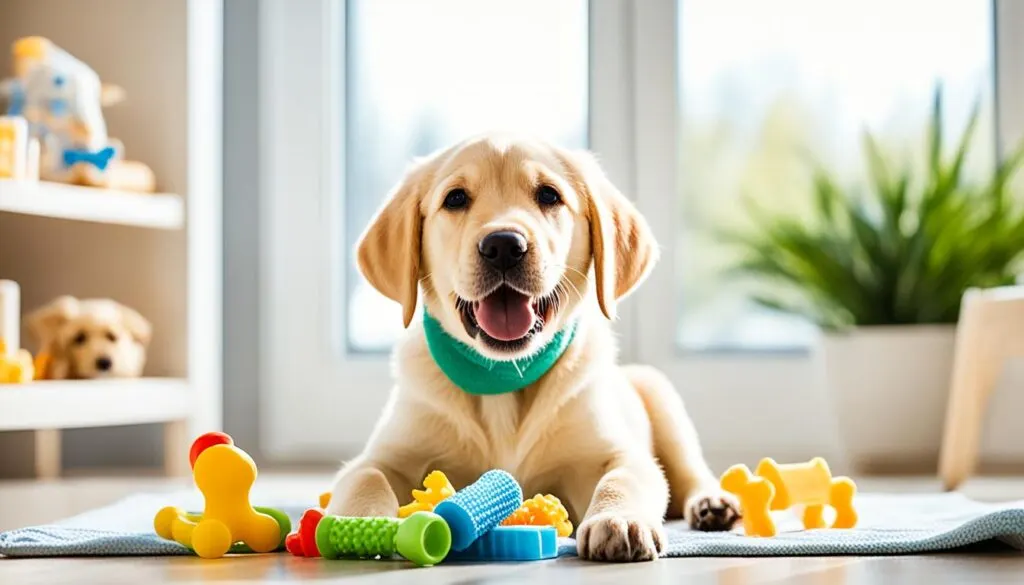Welcoming a Labrador puppy into your home is an exciting and joyous experience.
As your furry companion grows, you’ll witness key milestones, including their teething stage. Labrador puppy teething is a natural process that can cause discomfort for your little one.
However, with the right knowledge and care, you can make this phase more manageable and support their healthy development.
Click Here to Jump to a Section
Key Takeaways:
- Labrador puppy teething is a normal part of their development, but it can be uncomfortable for them.
- Understanding the different stages of teething can help you anticipate your puppy’s needs.
- Common symptoms of teething in Labrador puppies include chewing, drooling, and discomfort.
- There are various remedies, such as cold treats, teething toys, and gentle massages, that can provide relief.
- Choosing safe and appropriate teething toys can help your puppy relieve pain and strengthen their teeth.
Now that you’re aware of the importance of Labrador puppy teething and how it can impact your furry friend’s overall well-being, let’s delve deeper into the stages, symptoms, remedies, and tips to navigate this exciting yet challenging phase together.

Labrador Puppy Teething Stages
As your Labrador puppy grows, they will go through several teething stages on their way to developing their adult teeth.
Understanding these stages will help you anticipate your puppy’s needs and provide appropriate care during this vital period of their development.
Stage 1: Baby Teeth Eruption
During the first few weeks of life, Labrador puppies begin to develop their baby teeth, also known as deciduous teeth.
These sharp little teeth start to emerge around 3 to 4 weeks of age and will fully come in by approximately 6 to 8 weeks.
At this stage, your puppy will experience minor discomfort and may start to nibble on objects to relieve the teething pain.
Stage 2: Baby Teeth Shedding
Around 4 to 6 months of age, your Labrador puppy will begin the process of shedding their baby teeth to make way for their permanent adult teeth.
This stage can last several weeks and is often characterized by increased chewing, teething discomfort, and occasional bleeding gums.
It’s essential to provide appropriate teething aids to prevent destructive chewing and soothe your puppy’s sore gums.
Stage 3: Adult Teeth Eruption
As your Labrador puppy reaches 4 to 7 months old, their adult teeth will start to emerge.
The incisors usually come in first, followed by the canine teeth, premolars, and finally, the molars. By the time your puppy is 6 to 7 months old, they should have a full set of 42 adult teeth.
During this stage, your puppy may experience some tenderness and mild discomfort, but it should gradually subside as their teeth fully develop.
Stage 4: Maturation of Adult Teeth
Between 7 to 12 months of age, your Labrador puppy’s adult teeth will continue to mature and strengthen.
The roots of the teeth grow and anchor securely into the jawbone, providing a strong foundation for healthy chewing and proper dental health.
At this stage, your puppy’s teeth should be fully functional, and they should have outgrown most of the teething-related challenges.
It’s important to note that the timeline for Labrador puppy teething stages can vary from one dog to another.
Some puppies may go through these stages earlier or later than the average timeframe.
If you have any concerns or questions about your Labrador puppy’s teething process, consult with your veterinarian to ensure their dental health is on track.
| Teething Stage | Age Range | Developmental Milestones |
|---|---|---|
| Stage 1: Baby Teeth Eruption | 3 to 8 weeks | – Baby teeth start to come in – Mild discomfort and chewing behavior |
| Stage 2: Baby Teeth Shedding | 4 to 6 months | – Baby teeth start to fall out – Increased chewing and sore gums |
| Stage 3: Adult Teeth Eruption | 4 to 7 months | – Adult teeth emerge – Possible tenderness and discomfort |
| Stage 4: Maturation of Adult Teeth | 7 to 12 months | – Adult teeth fully develop – Teeth become strong and functional |
Labrador Puppy Teething Symptoms
As your Labrador puppy goes through the teething process, it’s important to be aware of the common signs and symptoms of teething.
By recognizing these symptoms, you can provide your puppy with appropriate care and support during this stage of their development.
- Chewing: One of the most noticeable symptoms of teething in Labrador puppies is increased chewing behavior. Your puppy may chew on various objects, such as toys, furniture, or even their own paws, to relieve the discomfort caused by teething.
- Drooling: Excessive drooling is another common symptom of Labrador puppy teething. The increased saliva production helps to soothe their gums but may lead to wet patches on furniture or the floor.
- Discomfort: Labrador puppies may experience discomfort or pain in their gums during the teething process. This can result in irritability, restlessness, or even a decreased appetite. It’s important to provide your puppy with gentle care and avoid putting pressure on their sensitive gums.
By recognizing these symptoms, you can ensure that your Labrador puppy receives the necessary care and attention during their teething journey.
Patience, understanding, and appropriate remedies can help your puppy navigate through this phase with more comfort and ease.
Labrador Puppy Teething Remedies
During the teething stage, Labrador puppies may experience discomfort and irritation as their adult teeth start to emerge.
Luckily, there are various remedies you can use to alleviate their teething woes and provide them with much-needed relief.
1. Cold Treats
Giving your Labrador puppy cold treats can help soothe their sore gums.
Try offering them frozen fruits, such as sliced apples or carrots, or freezing their regular treats to create a cooling sensation.
Always ensure the treats are safe for your puppy to consume and monitor them to prevent any choking hazards.

2. Teething Toys
Teething toys specifically designed for puppies are another great option to provide relief. Look for toys made of durable materials that are safe for chewing.
Consider toys with different textures and shapes to engage your puppy’s interest and help massage their gums.
Remember to supervise your puppy while they play with toys to prevent any accidents.
3. Gentle Massages
A gentle gum massage can go a long way in soothing your Labrador puppy’s teething discomfort.
Wash your hands thoroughly and apply light pressure to their gums using your fingertips.
This technique can help alleviate pain and promote healthy blood flow to the gums.
Use a gentle touch to avoid causing any pain or discomfort to your puppy.
By implementing these Labrador puppy teething remedies, you can provide your furry friend with the relief they need during this challenging stage of development.
Remember to always prioritize their safety and consult with a veterinarian if you have any concerns.
Labrador Puppy Teething Toys
During the teething phase, Labrador puppies experience discomfort as their baby teeth are replaced by permanent adult teeth.
Providing them with appropriate teething toys can help relieve their pain and promote healthy dental development. Here are some safe and recommended toys to consider:
- Nylabone Puppy Teething Pacifier: This durable and textured chew toy is designed to soothe your Labrador puppy’s gums and encourage healthy chewing habits. It is made from non-toxic materials and is suitable for puppies up to 25 pounds.
- KONG Puppy Toy: The KONG Puppy toy is made of natural rubber and can be stuffed with treats or frozen for added relief during the teething phase. It provides mental stimulation and helps redirect your puppy’s chewing behavior.
- Chuckit! Ultra Ball: This high-bouncing and durable ball is perfect for interactive play. It is made from natural rubber and is gentle on your puppy’s teeth and gums. The bright colors also make it easy to spot during outdoor play sessions.
- ZippyPaws Loopy Hedgehog Squeaky Plush Toy: Soft plush toys with squeakers can be comforting for Labrador puppies during teething. The ZippyPaws Loopy Hedgehog is a cute and durable option that provides both sensory stimulation and a comfort object.
- Benebone Maplestick: The Benebone Maplestick is a flavored chew toy made from real maple wood. Its unique shape and texture make it enticing for Labrador puppies to chew on, promoting dental health and preventing destructive chewing behavior.
Tips for Choosing Labrador Puppy Teething Toys:
- Ensure the toys are made from safe and non-toxic materials.
- Choose toys that are appropriate for your puppy’s size and age.
- Opt for toys with different textures and shapes to provide variety and encourage healthy chewing.
- Avoid toys with small parts or easily detachable pieces that may pose a choking hazard.
- Regularly inspect the toys for any signs of damage or wear and replace them as needed.
By offering Labrador puppy teething toys that are specifically designed for their needs, you can help alleviate discomfort, promote healthy dental development, and prevent your puppy from chewing on inappropriate objects.

Labrador Puppy Teething Tips
If you’re a proud owner of a Labrador puppy going through the teething phase, it’s essential to have a plan in place to help them through this uncomfortable time.
Here are some expert tips to navigate the teething phase with your Labrador puppy:
Establish a Teething Routine
Creating a consistent routine can provide structure and comfort to your Labrador puppy during their teething phase.
Aim to schedule regular playtimes, meal times, and rest periods to help your puppy adjust to the changes happening in their mouth.
Provide Chew Toys and Treats
Labrador puppies have a natural urge to chew while teething.
To prevent them from chewing on inappropriate objects, provide a variety of teething toys and treats specifically designed for pups.
Look for toys made of durable materials that can withstand heavy chewing.
Always supervise your puppy while they are chewing to ensure their safety, and avoid toys that could potentially break into small pieces or pose a choking hazard.
Use Cold Compresses
A cold compress can help soothe your Labrador puppy’s sore gums during the teething process. Wrap a soft cloth around an ice cube or use a frozen teething toy to provide relief to your puppy’s gums.
Try Gentle Massage
Gently massaging your Labrador puppy’s gums with clean fingers can help alleviate their teething discomfort.
Ensure that your hands are clean before attempting a gentle massage and use light pressure to avoid causing any pain.
Practice Positive Reinforcement
During the teething phase, it’s essential to continue training your Labrador puppy using positive reinforcement techniques.
Reward good behavior with praise, treats, or playtime to encourage them to refrain from destructive chewing habits.
Remember, every Labrador puppy’s teething experience is unique, so be patient and understanding during this period.
With these helpful tips, you’ll be able to provide your Labrador puppy with the support they need to navigate the teething phase successfully.
Labrador Puppy Teething Problems
While Labrador puppy teething is a normal process, it can sometimes come with a few problems that require attention.
Understanding these potential issues can help you provide the necessary care and address them promptly.
Retained Baby Teeth
One common teething problem in Labrador puppies is retained baby teeth.
It occurs when the adult teeth start to come in, but the baby teeth do not fall out as expected. Retained baby teeth can cause overcrowding, misalignment, and discomfort for your puppy.
If you notice your Labrador puppy still has baby teeth once their adult teeth have fully emerged, consult with your veterinarian.
They may need to extract the retained baby teeth to prevent complications and ensure proper alignment of the adult teeth.
Excessive Chewing
Another issue Labrador puppies may face during teething is excessive chewing.
As their gums become inflamed and they experience discomfort, they may seek relief by chewing on anything they can find, including furniture, shoes, or household objects.
To address excessive chewing, provide your puppy with appropriate teething toys and chew treats.
These will help soothe their gums and redirect their chewing behavior to more acceptable items.
Additionally, ensure your home is puppy-proofed, keeping valuable or dangerous items out of your puppy’s reach.
By being aware of potential teething problems and taking proactive measures, you can ensure a smooth transition for your Labrador puppy during this developmental stage.
Remember, always consult with your veterinarian for personalized advice and guidance.
Supporting Healthy Development in Labrador Puppies
Supporting your Labrador puppy’s healthy development is crucial, and this includes their teething process.
Labrador puppies typically begin teething around the age of 3 to 4 months, and this stage can last up to 6 months.
During this time, their baby teeth will start to fall out, making way for their permanent adult teeth.
To ensure proper development, it is important to provide your Labrador puppy with appropriate dental care.
Regular brushing of their teeth using a dog-specific toothbrush and toothpaste can help maintain good oral hygiene and prevent dental issues as they grow older.
Start this routine early to get your puppy accustomed to the process.
Additionally, providing your Labrador puppy with a balanced diet rich in essential nutrients is vital for their overall growth and teething process.
Consult your veterinarian for guidance on the best diet plan for your puppy’s specific needs.
Another key aspect of supporting healthy development during teething is monitoring the progress of your Labrador puppy’s adult teeth.
By the age of 6 to 7 months, their adult teeth should be fully in place. If you notice any delays or abnormalities, it is important to seek veterinary advice to address any potential issues promptly.
